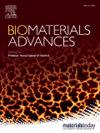使用人工智能驱动的硅工具设计仿生细胞穿透肽的策略用于药物输送。
IF 5.5
2区 医学
Q2 MATERIALS SCIENCE, BIOMATERIALS
Materials Science & Engineering C-Materials for Biological Applications
Pub Date : 2024-12-16
DOI:10.1016/j.bioadv.2024.214153
引用次数: 0
摘要
细胞穿透肽(CPP)在过去的25年里得到了迅速的关注;这要归功于它们的多功能性、定制性,以及避开免疫系统的“特洛伊木马”式递送。然而,目前的CPP合理设计过程是有限的,因为它需要多轮肽合成,预测和湿实验室验证,这是昂贵的,耗时的,并且需要广泛的肽化学知识。人工智能(AI)已经成为一种有前途的替代方案,可以增强设计过程,例如通过确定物理化学特性、二级结构、溶剂可及性、无序性和灵活性,以及预测体内行为,如毒性和肽酶降解。其他最近的工具利用监督机器学习(ML)来预测氨基酸序列的渗透能力。在CPP设计过程中使用人工智能有可能降低开发成本,并增加交付成功的机会。本综述提供了可用于设计过程的计算机工具和人工智能平台的调查,以及在设计下一代CPPs时应考虑的关键特征。本文章由计算机程序翻译,如有差异,请以英文原文为准。
Strategies for the design of biomimetic cell-penetrating peptides using AI-driven in silico tools for drug delivery
Cell-penetrating peptides (CPP) have gained rapid attention over the last 25 years; this is attributed to their versatility, customisation, and ‘Trojan horse’ delivery that evades the immune system. However, the current CPP rational design process is limited, as it requires several rounds of peptide synthesis, prediction and wet-lab validation, which is expensive, time-consuming and requires extensive knowledge in peptide chemistry. Artificial intelligence (AI) has emerged as a promising alternative which can augment the design process, for example by determining physiochemical characteristics, secondary structure, solvent accessibility, disorder and flexibility, as well as predicting in vivo behaviour such as toxicity and peptidase degradation. Other more recent tools utilise supervised machine learning (ML) to predict the penetrative ability of an amino acid sequence. The use of AI in the CPP design process has the potential to reduce development costs and increase the chances of success with respect to delivery. This review provides a survey of in silico tools and AI platforms which can be utilised in the design process, and the key features that should be taken into consideration when designing next generation CPPs.
求助全文
通过发布文献求助,成功后即可免费获取论文全文。
去求助
来源期刊
CiteScore
17.80
自引率
0.00%
发文量
501
审稿时长
27 days
期刊介绍:
Biomaterials Advances, previously known as Materials Science and Engineering: C-Materials for Biological Applications (P-ISSN: 0928-4931, E-ISSN: 1873-0191). Includes topics at the interface of the biomedical sciences and materials engineering. These topics include:
• Bioinspired and biomimetic materials for medical applications
• Materials of biological origin for medical applications
• Materials for "active" medical applications
• Self-assembling and self-healing materials for medical applications
• "Smart" (i.e., stimulus-response) materials for medical applications
• Ceramic, metallic, polymeric, and composite materials for medical applications
• Materials for in vivo sensing
• Materials for in vivo imaging
• Materials for delivery of pharmacologic agents and vaccines
• Novel approaches for characterizing and modeling materials for medical applications
Manuscripts on biological topics without a materials science component, or manuscripts on materials science without biological applications, will not be considered for publication in Materials Science and Engineering C. New submissions are first assessed for language, scope and originality (plagiarism check) and can be desk rejected before review if they need English language improvements, are out of scope or present excessive duplication with published sources.
Biomaterials Advances sits within Elsevier''s biomaterials science portfolio alongside Biomaterials, Materials Today Bio and Biomaterials and Biosystems. As part of the broader Materials Today family, Biomaterials Advances offers authors rigorous peer review, rapid decisions, and high visibility. We look forward to receiving your submissions!

 求助内容:
求助内容: 应助结果提醒方式:
应助结果提醒方式:


